Australian Corporate Insolvency Law
VerifiedAdded on 2020/03/28
|9
|2744
|38
AI Summary
This assignment delves into the intricacies of Australian corporate insolvency law. It examines the process of company winding up, including the factors considered by courts when deciding whether to wind up a company. The assignment also analyzes the duties owed by directors to creditors during insolvency and explores the impact of insolvency on various stakeholders, such as employees, suppliers, and customers.
Contribute Materials
Your contribution can guide someone’s learning journey. Share your
documents today.
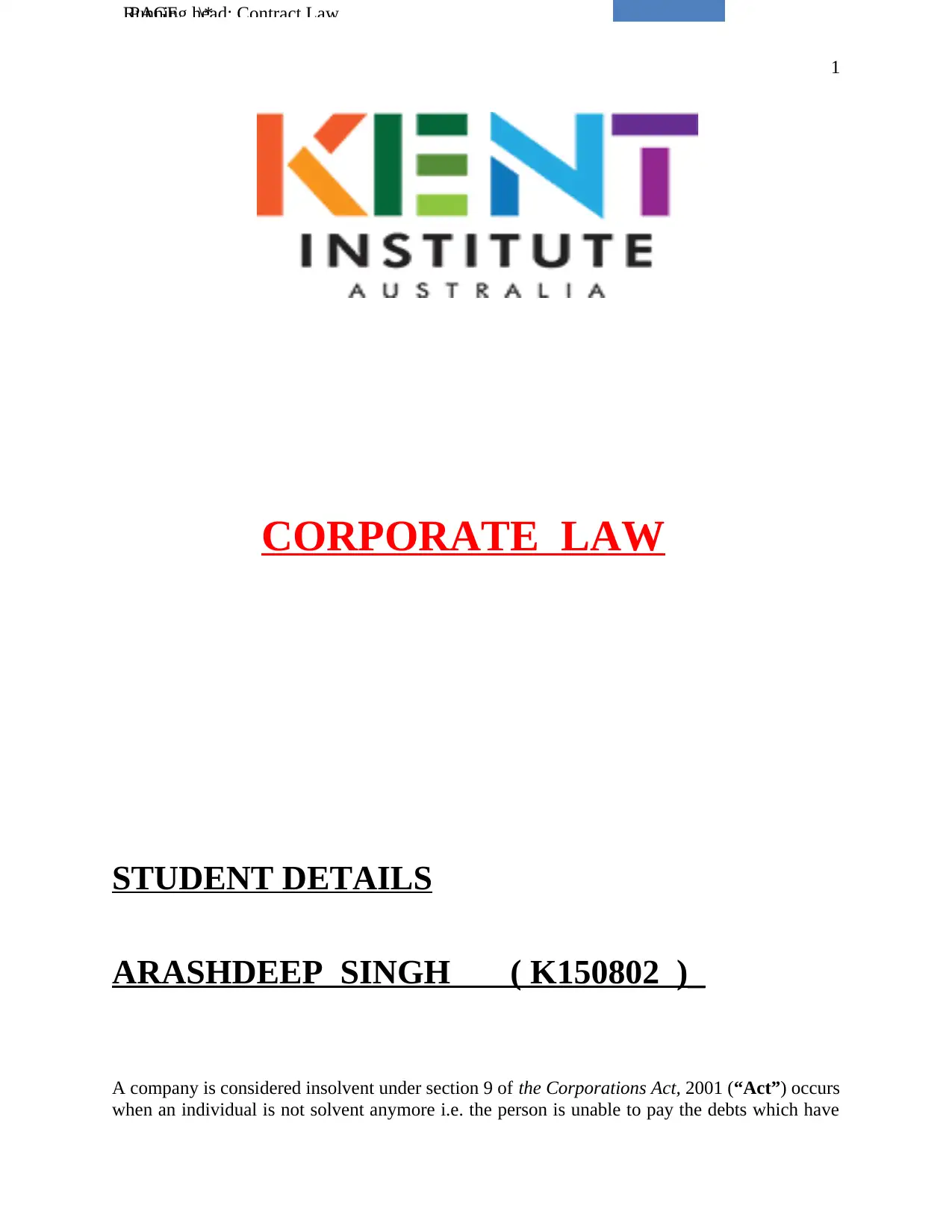
Running head: Contract LawPAGE \*
1
CORPORATE LAW
STUDENT DETAILS
ARASHDEEP SINGH ( K150802 )_
A company is considered insolvent under section 9 of the Corporations Act, 2001 (“Act”) occurs
when an individual is not solvent anymore i.e. the person is unable to pay the debts which have
1
CORPORATE LAW
STUDENT DETAILS
ARASHDEEP SINGH ( K150802 )_
A company is considered insolvent under section 9 of the Corporations Act, 2001 (“Act”) occurs
when an individual is not solvent anymore i.e. the person is unable to pay the debts which have
Secure Best Marks with AI Grader
Need help grading? Try our AI Grader for instant feedback on your assignments.
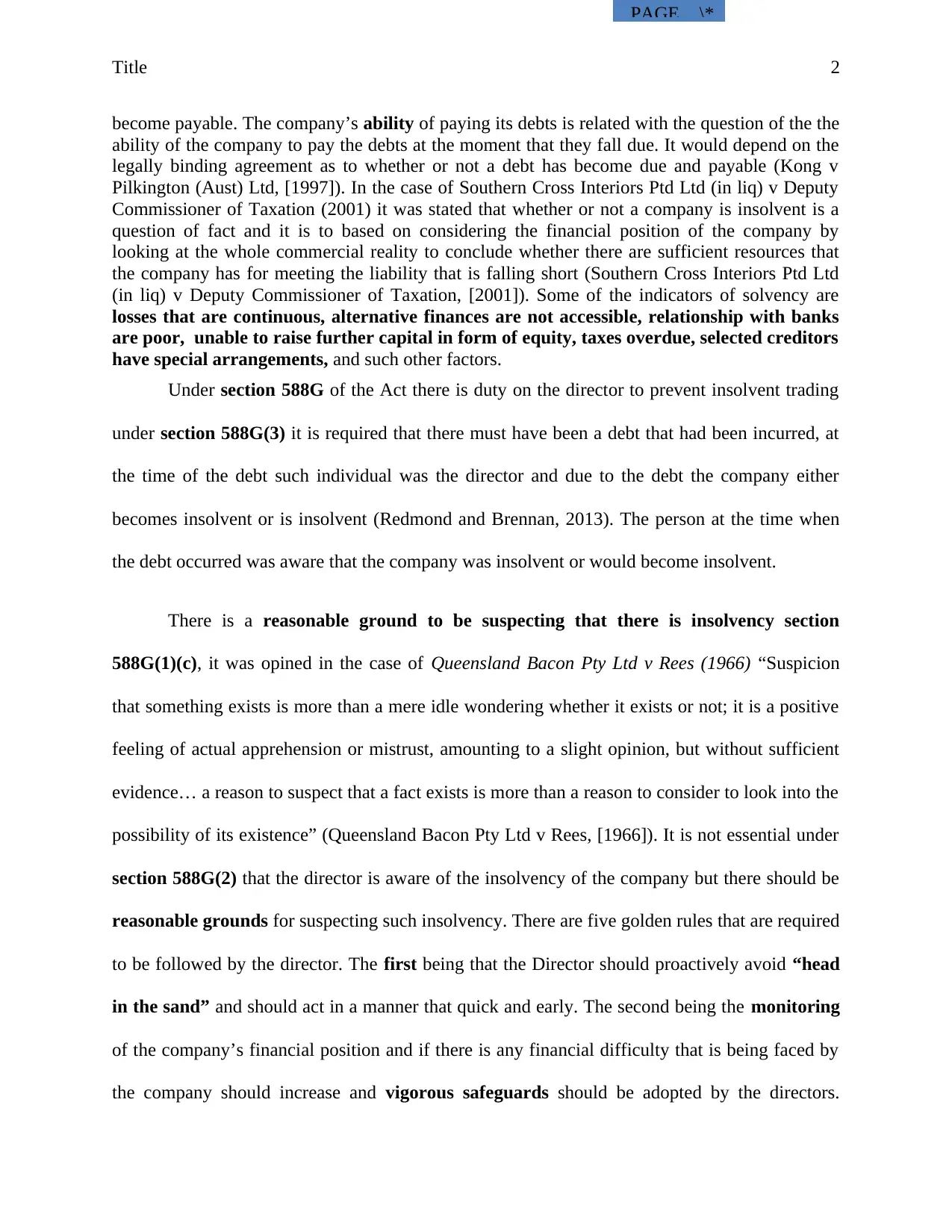
PAGE \*
Title 2
become payable. The company’s ability of paying its debts is related with the question of the the
ability of the company to pay the debts at the moment that they fall due. It would depend on the
legally binding agreement as to whether or not a debt has become due and payable (Kong v
Pilkington (Aust) Ltd, [1997]). In the case of Southern Cross Interiors Ptd Ltd (in liq) v Deputy
Commissioner of Taxation (2001) it was stated that whether or not a company is insolvent is a
question of fact and it is to based on considering the financial position of the company by
looking at the whole commercial reality to conclude whether there are sufficient resources that
the company has for meeting the liability that is falling short (Southern Cross Interiors Ptd Ltd
(in liq) v Deputy Commissioner of Taxation, [2001]). Some of the indicators of solvency are
losses that are continuous, alternative finances are not accessible, relationship with banks
are poor, unable to raise further capital in form of equity, taxes overdue, selected creditors
have special arrangements, and such other factors.
Under section 588G of the Act there is duty on the director to prevent insolvent trading
under section 588G(3) it is required that there must have been a debt that had been incurred, at
the time of the debt such individual was the director and due to the debt the company either
becomes insolvent or is insolvent (Redmond and Brennan, 2013). The person at the time when
the debt occurred was aware that the company was insolvent or would become insolvent.
There is a reasonable ground to be suspecting that there is insolvency section
588G(1)(c), it was opined in the case of Queensland Bacon Pty Ltd v Rees (1966) “Suspicion
that something exists is more than a mere idle wondering whether it exists or not; it is a positive
feeling of actual apprehension or mistrust, amounting to a slight opinion, but without sufficient
evidence… a reason to suspect that a fact exists is more than a reason to consider to look into the
possibility of its existence” (Queensland Bacon Pty Ltd v Rees, [1966]). It is not essential under
section 588G(2) that the director is aware of the insolvency of the company but there should be
reasonable grounds for suspecting such insolvency. There are five golden rules that are required
to be followed by the director. The first being that the Director should proactively avoid “head
in the sand” and should act in a manner that quick and early. The second being the monitoring
of the company’s financial position and if there is any financial difficulty that is being faced by
the company should increase and vigorous safeguards should be adopted by the directors.
Title 2
become payable. The company’s ability of paying its debts is related with the question of the the
ability of the company to pay the debts at the moment that they fall due. It would depend on the
legally binding agreement as to whether or not a debt has become due and payable (Kong v
Pilkington (Aust) Ltd, [1997]). In the case of Southern Cross Interiors Ptd Ltd (in liq) v Deputy
Commissioner of Taxation (2001) it was stated that whether or not a company is insolvent is a
question of fact and it is to based on considering the financial position of the company by
looking at the whole commercial reality to conclude whether there are sufficient resources that
the company has for meeting the liability that is falling short (Southern Cross Interiors Ptd Ltd
(in liq) v Deputy Commissioner of Taxation, [2001]). Some of the indicators of solvency are
losses that are continuous, alternative finances are not accessible, relationship with banks
are poor, unable to raise further capital in form of equity, taxes overdue, selected creditors
have special arrangements, and such other factors.
Under section 588G of the Act there is duty on the director to prevent insolvent trading
under section 588G(3) it is required that there must have been a debt that had been incurred, at
the time of the debt such individual was the director and due to the debt the company either
becomes insolvent or is insolvent (Redmond and Brennan, 2013). The person at the time when
the debt occurred was aware that the company was insolvent or would become insolvent.
There is a reasonable ground to be suspecting that there is insolvency section
588G(1)(c), it was opined in the case of Queensland Bacon Pty Ltd v Rees (1966) “Suspicion
that something exists is more than a mere idle wondering whether it exists or not; it is a positive
feeling of actual apprehension or mistrust, amounting to a slight opinion, but without sufficient
evidence… a reason to suspect that a fact exists is more than a reason to consider to look into the
possibility of its existence” (Queensland Bacon Pty Ltd v Rees, [1966]). It is not essential under
section 588G(2) that the director is aware of the insolvency of the company but there should be
reasonable grounds for suspecting such insolvency. There are five golden rules that are required
to be followed by the director. The first being that the Director should proactively avoid “head
in the sand” and should act in a manner that quick and early. The second being the monitoring
of the company’s financial position and if there is any financial difficulty that is being faced by
the company should increase and vigorous safeguards should be adopted by the directors.
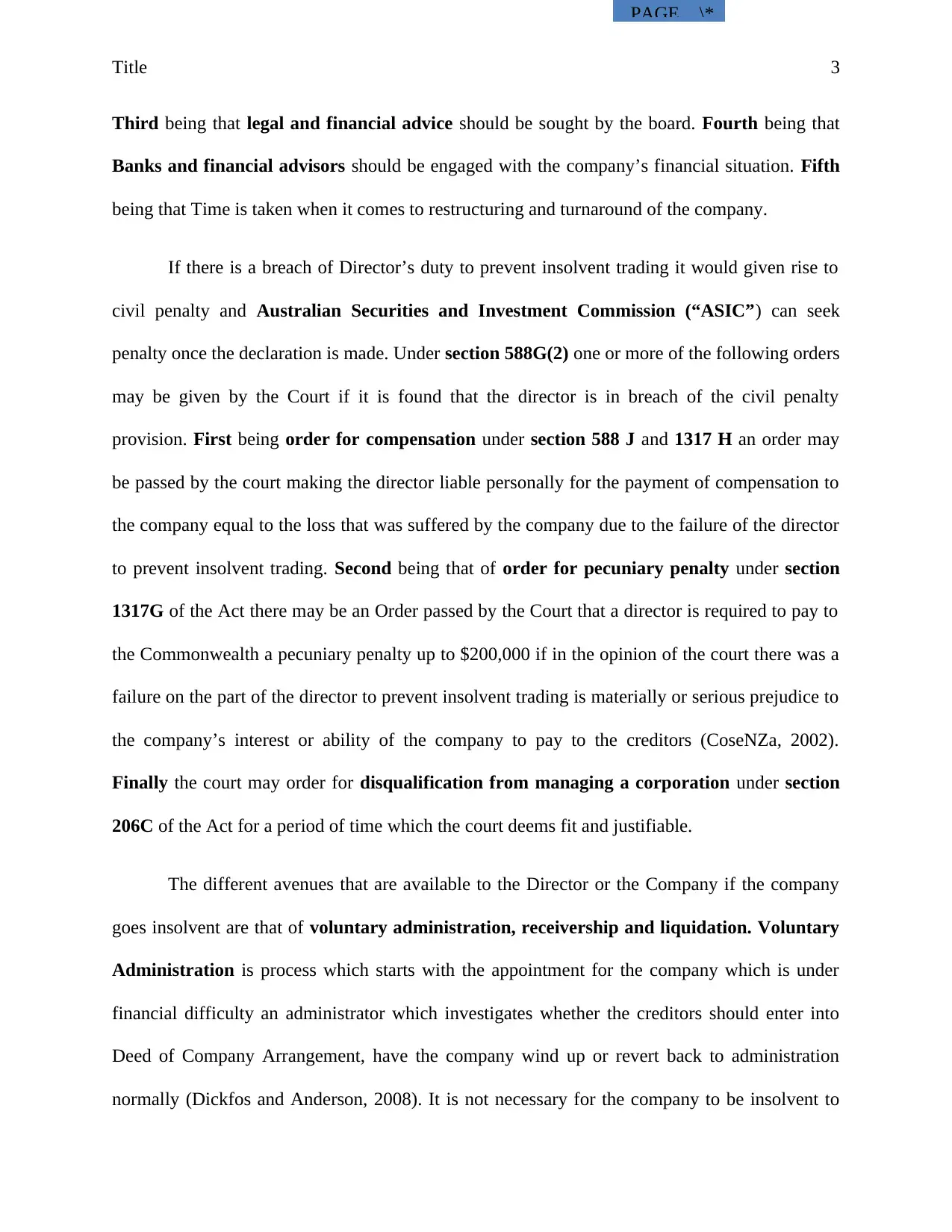
PAGE \*
Title 3
Third being that legal and financial advice should be sought by the board. Fourth being that
Banks and financial advisors should be engaged with the company’s financial situation. Fifth
being that Time is taken when it comes to restructuring and turnaround of the company.
If there is a breach of Director’s duty to prevent insolvent trading it would given rise to
civil penalty and Australian Securities and Investment Commission (“ASIC”) can seek
penalty once the declaration is made. Under section 588G(2) one or more of the following orders
may be given by the Court if it is found that the director is in breach of the civil penalty
provision. First being order for compensation under section 588 J and 1317 H an order may
be passed by the court making the director liable personally for the payment of compensation to
the company equal to the loss that was suffered by the company due to the failure of the director
to prevent insolvent trading. Second being that of order for pecuniary penalty under section
1317G of the Act there may be an Order passed by the Court that a director is required to pay to
the Commonwealth a pecuniary penalty up to $200,000 if in the opinion of the court there was a
failure on the part of the director to prevent insolvent trading is materially or serious prejudice to
the company’s interest or ability of the company to pay to the creditors (CoseNZa, 2002).
Finally the court may order for disqualification from managing a corporation under section
206C of the Act for a period of time which the court deems fit and justifiable.
The different avenues that are available to the Director or the Company if the company
goes insolvent are that of voluntary administration, receivership and liquidation. Voluntary
Administration is process which starts with the appointment for the company which is under
financial difficulty an administrator which investigates whether the creditors should enter into
Deed of Company Arrangement, have the company wind up or revert back to administration
normally (Dickfos and Anderson, 2008). It is not necessary for the company to be insolvent to
Title 3
Third being that legal and financial advice should be sought by the board. Fourth being that
Banks and financial advisors should be engaged with the company’s financial situation. Fifth
being that Time is taken when it comes to restructuring and turnaround of the company.
If there is a breach of Director’s duty to prevent insolvent trading it would given rise to
civil penalty and Australian Securities and Investment Commission (“ASIC”) can seek
penalty once the declaration is made. Under section 588G(2) one or more of the following orders
may be given by the Court if it is found that the director is in breach of the civil penalty
provision. First being order for compensation under section 588 J and 1317 H an order may
be passed by the court making the director liable personally for the payment of compensation to
the company equal to the loss that was suffered by the company due to the failure of the director
to prevent insolvent trading. Second being that of order for pecuniary penalty under section
1317G of the Act there may be an Order passed by the Court that a director is required to pay to
the Commonwealth a pecuniary penalty up to $200,000 if in the opinion of the court there was a
failure on the part of the director to prevent insolvent trading is materially or serious prejudice to
the company’s interest or ability of the company to pay to the creditors (CoseNZa, 2002).
Finally the court may order for disqualification from managing a corporation under section
206C of the Act for a period of time which the court deems fit and justifiable.
The different avenues that are available to the Director or the Company if the company
goes insolvent are that of voluntary administration, receivership and liquidation. Voluntary
Administration is process which starts with the appointment for the company which is under
financial difficulty an administrator which investigates whether the creditors should enter into
Deed of Company Arrangement, have the company wind up or revert back to administration
normally (Dickfos and Anderson, 2008). It is not necessary for the company to be insolvent to
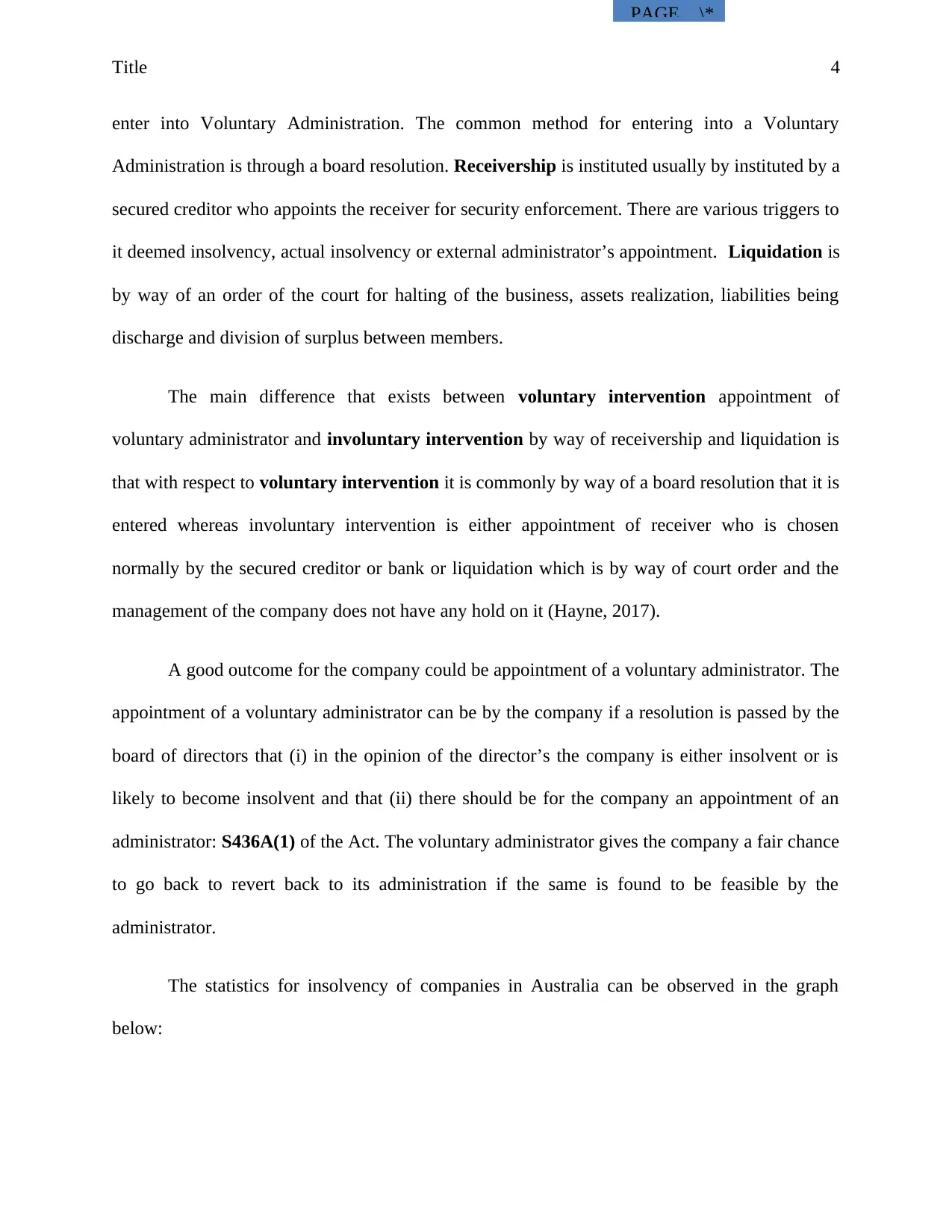
PAGE \*
Title 4
enter into Voluntary Administration. The common method for entering into a Voluntary
Administration is through a board resolution. Receivership is instituted usually by instituted by a
secured creditor who appoints the receiver for security enforcement. There are various triggers to
it deemed insolvency, actual insolvency or external administrator’s appointment. Liquidation is
by way of an order of the court for halting of the business, assets realization, liabilities being
discharge and division of surplus between members.
The main difference that exists between voluntary intervention appointment of
voluntary administrator and involuntary intervention by way of receivership and liquidation is
that with respect to voluntary intervention it is commonly by way of a board resolution that it is
entered whereas involuntary intervention is either appointment of receiver who is chosen
normally by the secured creditor or bank or liquidation which is by way of court order and the
management of the company does not have any hold on it (Hayne, 2017).
A good outcome for the company could be appointment of a voluntary administrator. The
appointment of a voluntary administrator can be by the company if a resolution is passed by the
board of directors that (i) in the opinion of the director’s the company is either insolvent or is
likely to become insolvent and that (ii) there should be for the company an appointment of an
administrator: S436A(1) of the Act. The voluntary administrator gives the company a fair chance
to go back to revert back to its administration if the same is found to be feasible by the
administrator.
The statistics for insolvency of companies in Australia can be observed in the graph
below:
Title 4
enter into Voluntary Administration. The common method for entering into a Voluntary
Administration is through a board resolution. Receivership is instituted usually by instituted by a
secured creditor who appoints the receiver for security enforcement. There are various triggers to
it deemed insolvency, actual insolvency or external administrator’s appointment. Liquidation is
by way of an order of the court for halting of the business, assets realization, liabilities being
discharge and division of surplus between members.
The main difference that exists between voluntary intervention appointment of
voluntary administrator and involuntary intervention by way of receivership and liquidation is
that with respect to voluntary intervention it is commonly by way of a board resolution that it is
entered whereas involuntary intervention is either appointment of receiver who is chosen
normally by the secured creditor or bank or liquidation which is by way of court order and the
management of the company does not have any hold on it (Hayne, 2017).
A good outcome for the company could be appointment of a voluntary administrator. The
appointment of a voluntary administrator can be by the company if a resolution is passed by the
board of directors that (i) in the opinion of the director’s the company is either insolvent or is
likely to become insolvent and that (ii) there should be for the company an appointment of an
administrator: S436A(1) of the Act. The voluntary administrator gives the company a fair chance
to go back to revert back to its administration if the same is found to be feasible by the
administrator.
The statistics for insolvency of companies in Australia can be observed in the graph
below:
Secure Best Marks with AI Grader
Need help grading? Try our AI Grader for instant feedback on your assignments.
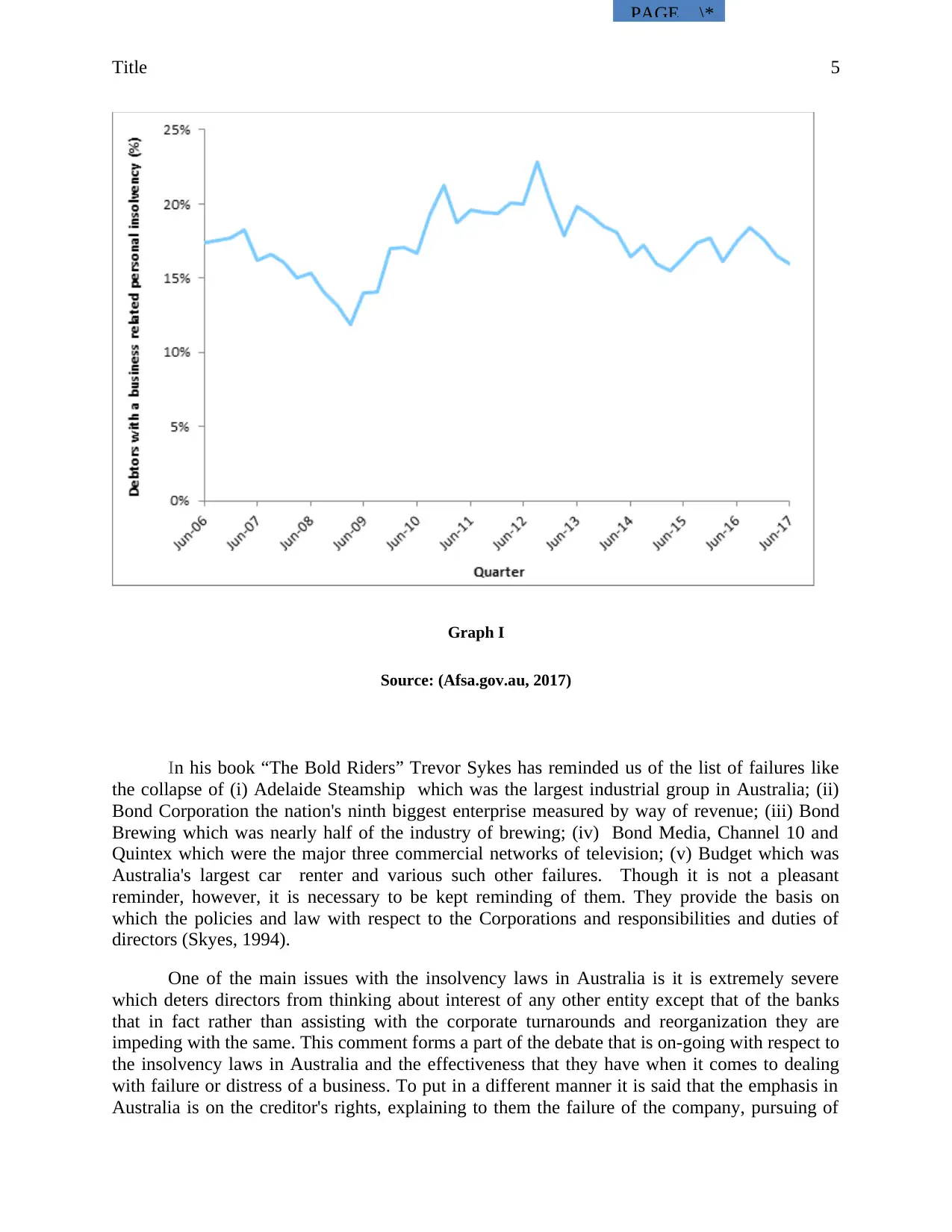
PAGE \*
Title 5
Graph I
Source: (Afsa.gov.au, 2017)
In his book “The Bold Riders” Trevor Sykes has reminded us of the list of failures like
the collapse of (i) Adelaide Steamship which was the largest industrial group in Australia; (ii)
Bond Corporation the nation's ninth biggest enterprise measured by way of revenue; (iii) Bond
Brewing which was nearly half of the industry of brewing; (iv) Bond Media, Channel 10 and
Quintex which were the major three commercial networks of television; (v) Budget which was
Australia's largest car renter and various such other failures. Though it is not a pleasant
reminder, however, it is necessary to be kept reminding of them. They provide the basis on
which the policies and law with respect to the Corporations and responsibilities and duties of
directors (Skyes, 1994).
One of the main issues with the insolvency laws in Australia is it is extremely severe
which deters directors from thinking about interest of any other entity except that of the banks
that in fact rather than assisting with the corporate turnarounds and reorganization they are
impeding with the same. This comment forms a part of the debate that is on-going with respect to
the insolvency laws in Australia and the effectiveness that they have when it comes to dealing
with failure or distress of a business. To put in a different manner it is said that the emphasis in
Australia is on the creditor's rights, explaining to them the failure of the company, pursuing of
Title 5
Graph I
Source: (Afsa.gov.au, 2017)
In his book “The Bold Riders” Trevor Sykes has reminded us of the list of failures like
the collapse of (i) Adelaide Steamship which was the largest industrial group in Australia; (ii)
Bond Corporation the nation's ninth biggest enterprise measured by way of revenue; (iii) Bond
Brewing which was nearly half of the industry of brewing; (iv) Bond Media, Channel 10 and
Quintex which were the major three commercial networks of television; (v) Budget which was
Australia's largest car renter and various such other failures. Though it is not a pleasant
reminder, however, it is necessary to be kept reminding of them. They provide the basis on
which the policies and law with respect to the Corporations and responsibilities and duties of
directors (Skyes, 1994).
One of the main issues with the insolvency laws in Australia is it is extremely severe
which deters directors from thinking about interest of any other entity except that of the banks
that in fact rather than assisting with the corporate turnarounds and reorganization they are
impeding with the same. This comment forms a part of the debate that is on-going with respect to
the insolvency laws in Australia and the effectiveness that they have when it comes to dealing
with failure or distress of a business. To put in a different manner it is said that the emphasis in
Australia is on the creditor's rights, explaining to them the failure of the company, pursuing of
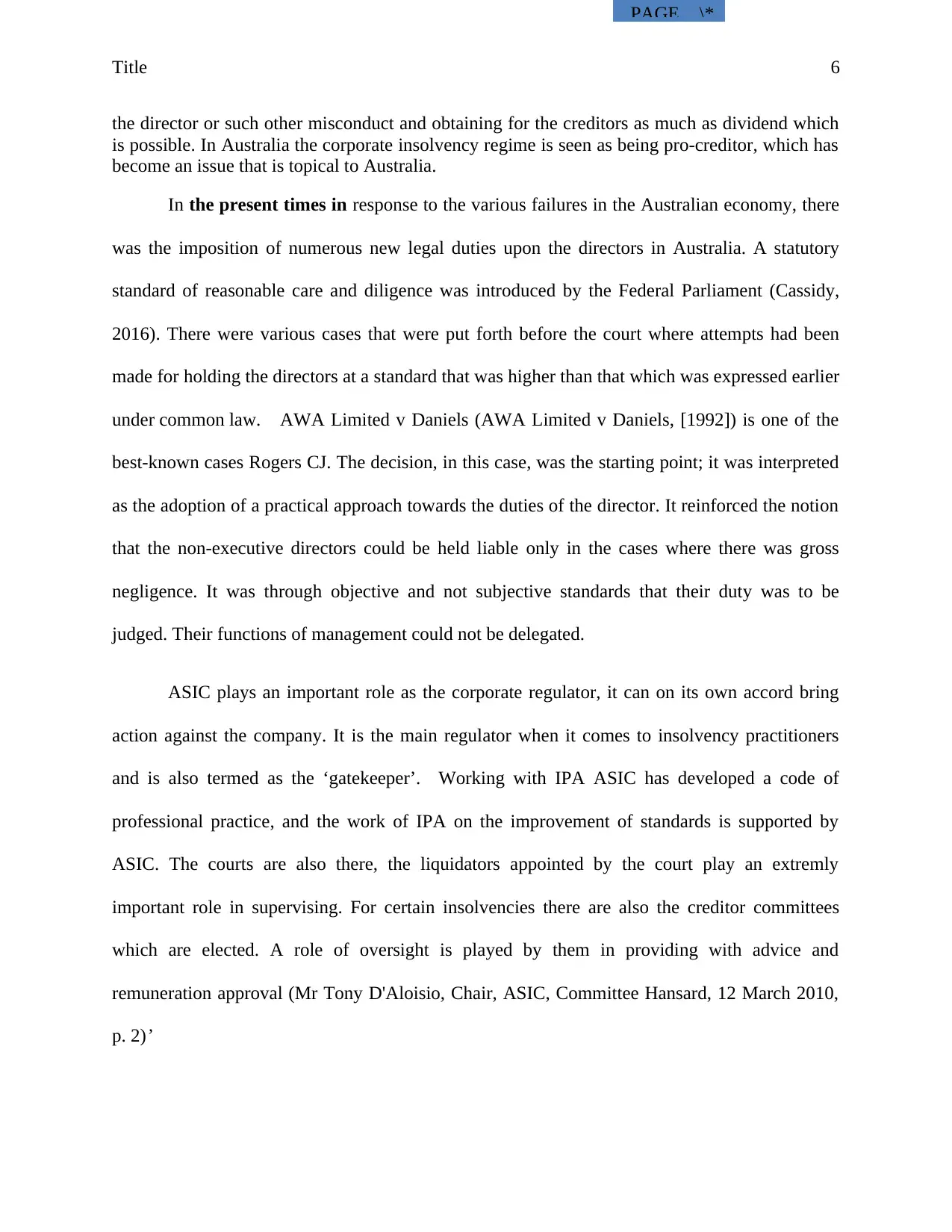
PAGE \*
Title 6
the director or such other misconduct and obtaining for the creditors as much as dividend which
is possible. In Australia the corporate insolvency regime is seen as being pro-creditor, which has
become an issue that is topical to Australia.
In the present times in response to the various failures in the Australian economy, there
was the imposition of numerous new legal duties upon the directors in Australia. A statutory
standard of reasonable care and diligence was introduced by the Federal Parliament (Cassidy,
2016). There were various cases that were put forth before the court where attempts had been
made for holding the directors at a standard that was higher than that which was expressed earlier
under common law. AWA Limited v Daniels (AWA Limited v Daniels, [1992]) is one of the
best-known cases Rogers CJ. The decision, in this case, was the starting point; it was interpreted
as the adoption of a practical approach towards the duties of the director. It reinforced the notion
that the non-executive directors could be held liable only in the cases where there was gross
negligence. It was through objective and not subjective standards that their duty was to be
judged. Their functions of management could not be delegated.
ASIC plays an important role as the corporate regulator, it can on its own accord bring
action against the company. It is the main regulator when it comes to insolvency practitioners
and is also termed as the ‘gatekeeper’. Working with IPA ASIC has developed a code of
professional practice, and the work of IPA on the improvement of standards is supported by
ASIC. The courts are also there, the liquidators appointed by the court play an extremly
important role in supervising. For certain insolvencies there are also the creditor committees
which are elected. A role of oversight is played by them in providing with advice and
remuneration approval (Mr Tony D'Aloisio, Chair, ASIC, Committee Hansard, 12 March 2010,
p. 2)’
Title 6
the director or such other misconduct and obtaining for the creditors as much as dividend which
is possible. In Australia the corporate insolvency regime is seen as being pro-creditor, which has
become an issue that is topical to Australia.
In the present times in response to the various failures in the Australian economy, there
was the imposition of numerous new legal duties upon the directors in Australia. A statutory
standard of reasonable care and diligence was introduced by the Federal Parliament (Cassidy,
2016). There were various cases that were put forth before the court where attempts had been
made for holding the directors at a standard that was higher than that which was expressed earlier
under common law. AWA Limited v Daniels (AWA Limited v Daniels, [1992]) is one of the
best-known cases Rogers CJ. The decision, in this case, was the starting point; it was interpreted
as the adoption of a practical approach towards the duties of the director. It reinforced the notion
that the non-executive directors could be held liable only in the cases where there was gross
negligence. It was through objective and not subjective standards that their duty was to be
judged. Their functions of management could not be delegated.
ASIC plays an important role as the corporate regulator, it can on its own accord bring
action against the company. It is the main regulator when it comes to insolvency practitioners
and is also termed as the ‘gatekeeper’. Working with IPA ASIC has developed a code of
professional practice, and the work of IPA on the improvement of standards is supported by
ASIC. The courts are also there, the liquidators appointed by the court play an extremly
important role in supervising. For certain insolvencies there are also the creditor committees
which are elected. A role of oversight is played by them in providing with advice and
remuneration approval (Mr Tony D'Aloisio, Chair, ASIC, Committee Hansard, 12 March 2010,
p. 2)’
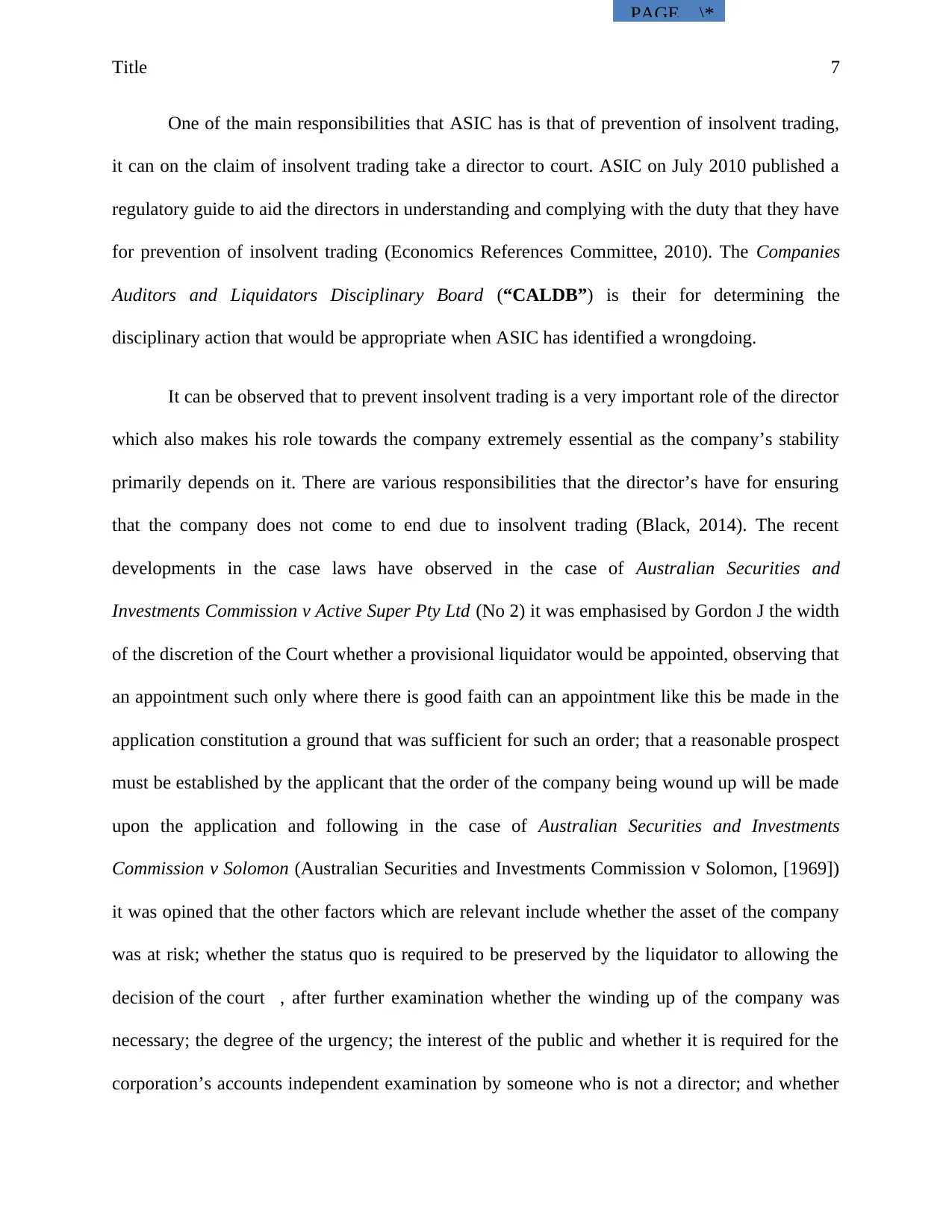
PAGE \*
Title 7
One of the main responsibilities that ASIC has is that of prevention of insolvent trading,
it can on the claim of insolvent trading take a director to court. ASIC on July 2010 published a
regulatory guide to aid the directors in understanding and complying with the duty that they have
for prevention of insolvent trading (Economics References Committee, 2010). The Companies
Auditors and Liquidators Disciplinary Board (“CALDB”) is their for determining the
disciplinary action that would be appropriate when ASIC has identified a wrongdoing.
It can be observed that to prevent insolvent trading is a very important role of the director
which also makes his role towards the company extremely essential as the company’s stability
primarily depends on it. There are various responsibilities that the director’s have for ensuring
that the company does not come to end due to insolvent trading (Black, 2014). The recent
developments in the case laws have observed in the case of Australian Securities and
Investments Commission v Active Super Pty Ltd (No 2) it was emphasised by Gordon J the width
of the discretion of the Court whether a provisional liquidator would be appointed, observing that
an appointment such only where there is good faith can an appointment like this be made in the
application constitution a ground that was sufficient for such an order; that a reasonable prospect
must be established by the applicant that the order of the company being wound up will be made
upon the application and following in the case of Australian Securities and Investments
Commission v Solomon (Australian Securities and Investments Commission v Solomon, [1969])
it was opined that the other factors which are relevant include whether the asset of the company
was at risk; whether the status quo is required to be preserved by the liquidator to allowing the
decision of the court , after further examination whether the winding up of the company was
necessary; the degree of the urgency; the interest of the public and whether it is required for the
corporation’s accounts independent examination by someone who is not a director; and whether
Title 7
One of the main responsibilities that ASIC has is that of prevention of insolvent trading,
it can on the claim of insolvent trading take a director to court. ASIC on July 2010 published a
regulatory guide to aid the directors in understanding and complying with the duty that they have
for prevention of insolvent trading (Economics References Committee, 2010). The Companies
Auditors and Liquidators Disciplinary Board (“CALDB”) is their for determining the
disciplinary action that would be appropriate when ASIC has identified a wrongdoing.
It can be observed that to prevent insolvent trading is a very important role of the director
which also makes his role towards the company extremely essential as the company’s stability
primarily depends on it. There are various responsibilities that the director’s have for ensuring
that the company does not come to end due to insolvent trading (Black, 2014). The recent
developments in the case laws have observed in the case of Australian Securities and
Investments Commission v Active Super Pty Ltd (No 2) it was emphasised by Gordon J the width
of the discretion of the Court whether a provisional liquidator would be appointed, observing that
an appointment such only where there is good faith can an appointment like this be made in the
application constitution a ground that was sufficient for such an order; that a reasonable prospect
must be established by the applicant that the order of the company being wound up will be made
upon the application and following in the case of Australian Securities and Investments
Commission v Solomon (Australian Securities and Investments Commission v Solomon, [1969])
it was opined that the other factors which are relevant include whether the asset of the company
was at risk; whether the status quo is required to be preserved by the liquidator to allowing the
decision of the court , after further examination whether the winding up of the company was
necessary; the degree of the urgency; the interest of the public and whether it is required for the
corporation’s accounts independent examination by someone who is not a director; and whether
Paraphrase This Document
Need a fresh take? Get an instant paraphrase of this document with our AI Paraphraser

PAGE \*
Title 8
it is with due regard that the affairs of the company have been carried out (Australian Securities
and Investments Commission v Active Super Pty Ltd (No 2), [2013]).
References
Afsa.gov.au. (2017). Business and non-business statistics | Australian Financial Security
Authority. [online] Available at: https://www.afsa.gov.au/statistics/business-and-non-
business-statistics [Accessed 19 Sep. 2017].
Australian Securities and Investment Commission. (2017). Corporate insolvencies: June
quarter 2017. [online] Available at:
http://download.asic.gov.au/media/4410590/201706-june-qtr-2017-summary-
analysis.pdf [Accessed 19 Sep. 2017].
Australian Securities and Investments Commission v Active Super Pty Ltd (No 2)
[2013]FCA 234 at ([12]–[15]); 93 ACSR 189.
Australian Securities and Investments Commission v Solomon [1969]19 ACSR 73.
AWA Limited v Daniels [1992]7 ACSR 759.
Black, A. (2014). Recent Developments in Corporate Law. Australian Corporations
Legislation; Lexis Nexis Buttersworth.
CoseNZa, I. (2002). The Impact of Insolvency on the Recovery of Penalties. Australian Law
Reform Commission Reform Journal.
Dickfos, J. and Anderson, C. (2008). The Sovereign Voluntary Administrator Position of the
Voluntary Administrator vis a` vis the company stakeholders. In: QUT Insolvency
Workshop. Griffith Research Online.
Economics References Committee (2010). The regulation, registration and remuneration of
insolvency practitioners in Australia: the case for a new framework. Senate Printing
Unit, Parliament House, Canberra.
Title 8
it is with due regard that the affairs of the company have been carried out (Australian Securities
and Investments Commission v Active Super Pty Ltd (No 2), [2013]).
References
Afsa.gov.au. (2017). Business and non-business statistics | Australian Financial Security
Authority. [online] Available at: https://www.afsa.gov.au/statistics/business-and-non-
business-statistics [Accessed 19 Sep. 2017].
Australian Securities and Investment Commission. (2017). Corporate insolvencies: June
quarter 2017. [online] Available at:
http://download.asic.gov.au/media/4410590/201706-june-qtr-2017-summary-
analysis.pdf [Accessed 19 Sep. 2017].
Australian Securities and Investments Commission v Active Super Pty Ltd (No 2)
[2013]FCA 234 at ([12]–[15]); 93 ACSR 189.
Australian Securities and Investments Commission v Solomon [1969]19 ACSR 73.
AWA Limited v Daniels [1992]7 ACSR 759.
Black, A. (2014). Recent Developments in Corporate Law. Australian Corporations
Legislation; Lexis Nexis Buttersworth.
CoseNZa, I. (2002). The Impact of Insolvency on the Recovery of Penalties. Australian Law
Reform Commission Reform Journal.
Dickfos, J. and Anderson, C. (2008). The Sovereign Voluntary Administrator Position of the
Voluntary Administrator vis a` vis the company stakeholders. In: QUT Insolvency
Workshop. Griffith Research Online.
Economics References Committee (2010). The regulation, registration and remuneration of
insolvency practitioners in Australia: the case for a new framework. Senate Printing
Unit, Parliament House, Canberra.
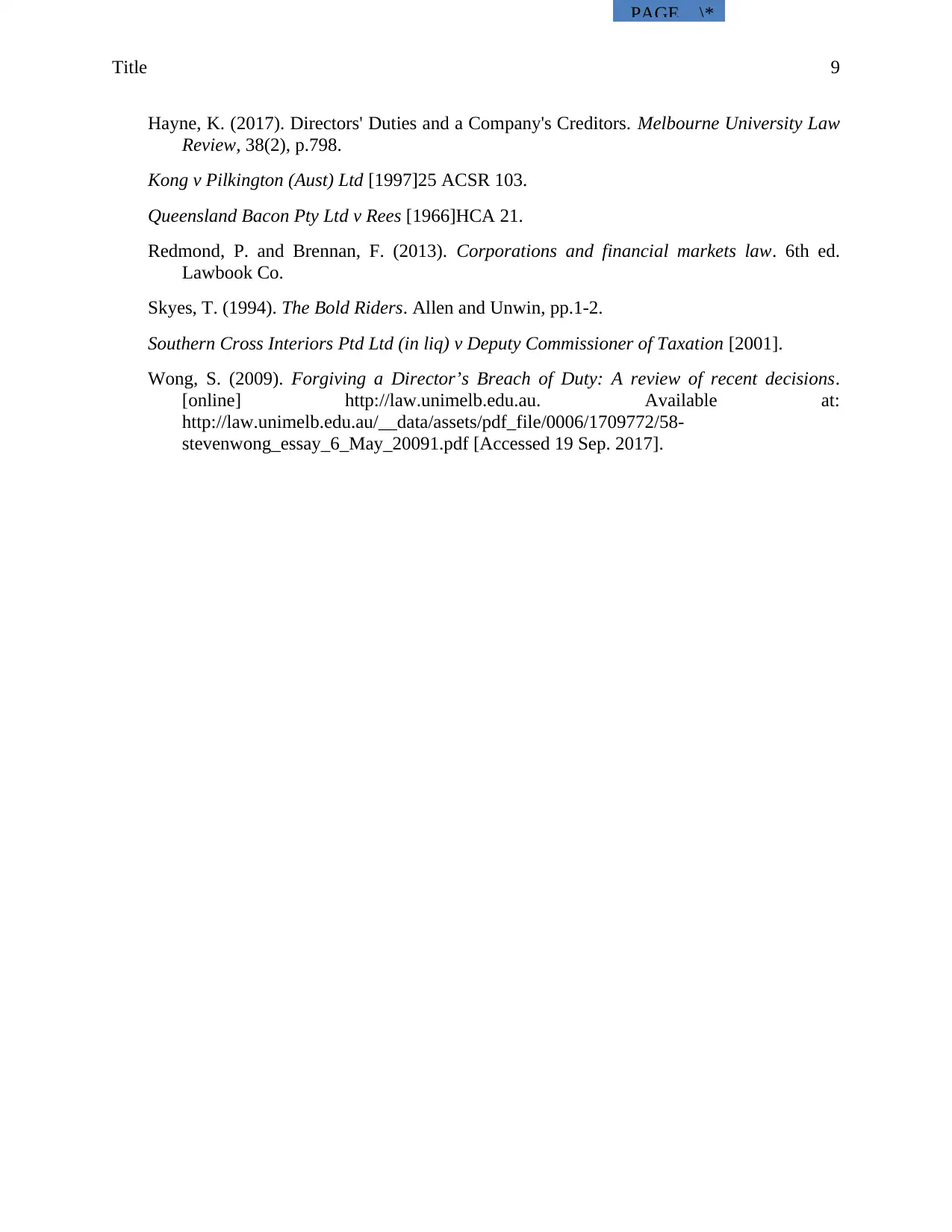
PAGE \*
Title 9
Hayne, K. (2017). Directors' Duties and a Company's Creditors. Melbourne University Law
Review, 38(2), p.798.
Kong v Pilkington (Aust) Ltd [1997]25 ACSR 103.
Queensland Bacon Pty Ltd v Rees [1966]HCA 21.
Redmond, P. and Brennan, F. (2013). Corporations and financial markets law. 6th ed.
Lawbook Co.
Skyes, T. (1994). The Bold Riders. Allen and Unwin, pp.1-2.
Southern Cross Interiors Ptd Ltd (in liq) v Deputy Commissioner of Taxation [2001].
Wong, S. (2009). Forgiving a Director’s Breach of Duty: A review of recent decisions.
[online] http://law.unimelb.edu.au. Available at:
http://law.unimelb.edu.au/__data/assets/pdf_file/0006/1709772/58-
stevenwong_essay_6_May_20091.pdf [Accessed 19 Sep. 2017].
Title 9
Hayne, K. (2017). Directors' Duties and a Company's Creditors. Melbourne University Law
Review, 38(2), p.798.
Kong v Pilkington (Aust) Ltd [1997]25 ACSR 103.
Queensland Bacon Pty Ltd v Rees [1966]HCA 21.
Redmond, P. and Brennan, F. (2013). Corporations and financial markets law. 6th ed.
Lawbook Co.
Skyes, T. (1994). The Bold Riders. Allen and Unwin, pp.1-2.
Southern Cross Interiors Ptd Ltd (in liq) v Deputy Commissioner of Taxation [2001].
Wong, S. (2009). Forgiving a Director’s Breach of Duty: A review of recent decisions.
[online] http://law.unimelb.edu.au. Available at:
http://law.unimelb.edu.au/__data/assets/pdf_file/0006/1709772/58-
stevenwong_essay_6_May_20091.pdf [Accessed 19 Sep. 2017].
1 out of 9
Related Documents
Your All-in-One AI-Powered Toolkit for Academic Success.
+13062052269
info@desklib.com
Available 24*7 on WhatsApp / Email
![[object Object]](/_next/static/media/star-bottom.7253800d.svg)
Unlock your academic potential
© 2024 | Zucol Services PVT LTD | All rights reserved.





